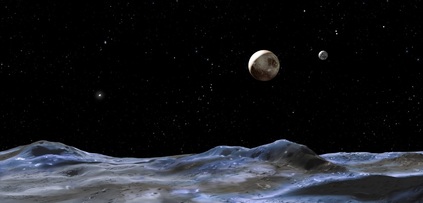
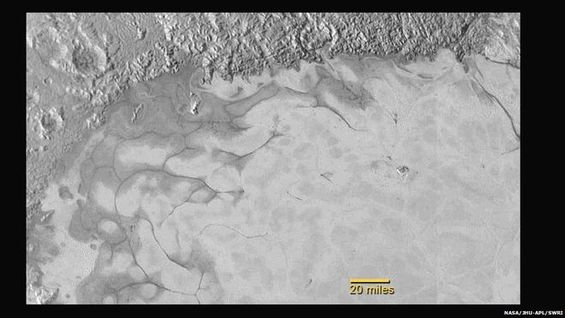
The third surface image shows a mountainous region in Pluto's southern hemisphere.
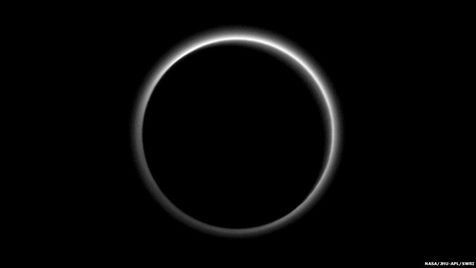
The images below show some of the features on Pluto's major moon Charon.
| How Spacecraft Fly |
|
 Since close approach of New Horizons to the Pluto system on 14 July the ground segment has been busy gathering image and science data from the spacecraft as it races away, ultimately to leave our Solar System. Although the data received so far represents only a small fraction of the total stored onboard, it nevertheless has wetted the appetite of the science team on the ground. As I said in my flyby preview blog (11 June 2015), it's going to take until nearly the end of next year to download all the scientific treasures, but here is just a small sample of some of the findings to date.  The following three images show hi-res close-ups of Pluto's surface. The surface features in some regions looks very alien and devoid of familiar landforms, making it difficult to interpret and to appreciate scale. The image to the right and below show ice covered plains - but not necessarily comprised of water ice. With an average surface temperature of -230 degrees Celsius, they are more likely comprised of frozen gaseous deposits of nitrogen, methane and carbon monoxide. The third surface image shows a mountainous region in Pluto's southern hemisphere.  During the encounter, the spacecraft 'flew' into Pluto's shadow to produce this rather splendid picture of a Plutonian solar eclipse. Scientifically this was a very valuable thing to do, as the planet's atmosphere (if it had one) would be backlighted by the Sun allowing measurements to be made of its structure and composition. Prior to the New Horizon's mission it was anticipated that Pluto might have an atmosphere. It was believed that when Pluto was closest to the Sun, surface ices would vapourise to produce an atmosphere, and then when it was at its greatest distance from the Sun, the atmosphere would freeze and collapse again onto the surface. Pluto's orbit is very elliptical, so when it is its closest to the Sun (perihelion) it is 30 AU from the Sun ( 1 AU = 1 Astronomical Unit = the mean Earth-Sun distance), and when at furthest distance (aphelion) it is 49 AU away. So Pluto's orbital position makes a big difference to the solar input. Currently Pluto is at about 33 AU from the Sun, and so fairly close to perihelion and maximum solar input, causing the atmosphere that can be seen in the image. However it is extremely tenuous - onboard sensors have measured a pressure of just a few millionths of the pressure here at Earth, with the composition being predominantly nitrogen, methane and carbon monoxide. The images below show some of the features on Pluto's major moon Charon.
0 Comments
 Lots of happy New Horizons team members after Pluto encounter yesterday (14 July 2015) Lots of happy New Horizons team members after Pluto encounter yesterday (14 July 2015) Well, the new Horizons spacecraft appears to have achieved a successful flyby of the Pluto system yesterday with much celebrating at mission control in Maryland USA. However, as the close encounter was controlled autonomously, we will have to wait a while to see if all the data and image gathering tasks were performed correctly. But so far all looks good, with the spacecraft re-establishing a telemetry link with the ground today (Wednesday 15 July 2015), indicating the the spacecraft is healthy after its close approach. Prior to this the spacecraft was able to transmit some hi-res images, a couple of which are shown below. Watch this space for more revelations over the coming days! 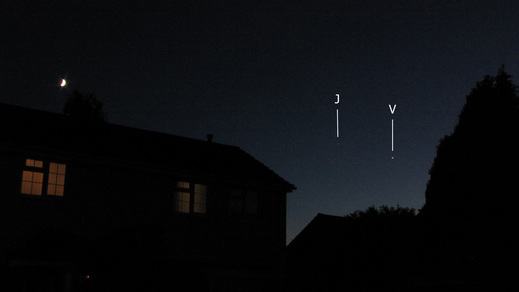 Crescent moon, Jupiter and Venus in the evening twilight taken on 22 June 2015. Crescent moon, Jupiter and Venus in the evening twilight taken on 22 June 2015. The close approach of the two brightest planets, Jupiter and Venus, occurred in the early hours of 1 July 2015. I have been watching this develop over the last couple of weeks or so, and using the x40 optical zoom on my bridge camera to try to capture some images of the event. The first picture shows the two planets accompanied by the crescent moon in the evening twilight on 22 June 2015. I couldn't resist trying to capture a picture of the crescent moon as well (second image) on that evening. 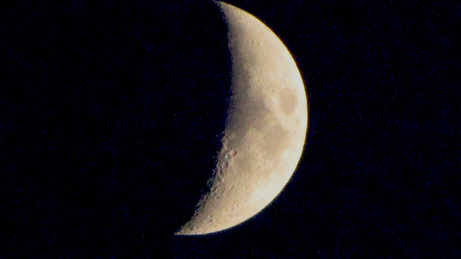 Crescent moon on 22 June 2015. Crescent moon on 22 June 2015. The last two pictures (below) show Jupiter and Venus near closest approach at around 22.10 BST (21.10 UT) on the evening of 30 June 2015. We had a beautiful clear sunny day in Southampton, UK on the 30th, but then at the crucial time in the evening cloud started to build, threatening thundery showers. However as the evening wore on the cloud eased, and just as I was beginning to think that they planets had set, I caught a glimpse of them low on the W horizon beneath the cloud cover. Strangely it was raining as I took the pictures - so I guess I was very lucky to see anything at all. This is the closest planetary conjunction this year. Jupiter is seen a little above Venus, both at an elevation of around 10 degrees above the WNW horizon. I estimated the separation at this time as 0.37 degrees (22 arcminutes), which is pretty close (about 2/3 the diameter of the full moon). It was obviously easy to see both objects in a single field of view of binoculars, and by coincidence theyhad the same apparent size disk (32 arcseconds). Venus's phase at the time was a 34% crescent, but unfortunately my binoculars were not good enough to see the crescent shape! |
AuthorGraham Swinerd - I hope to use this page to highlight current major events in space and spacececraft. Archives
November 2022
Categories |